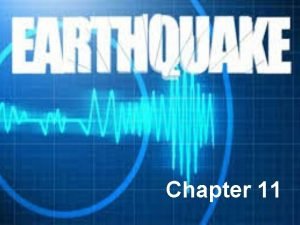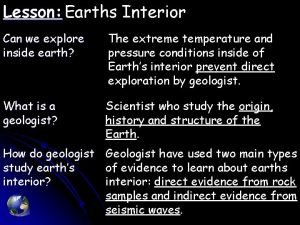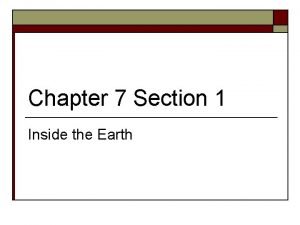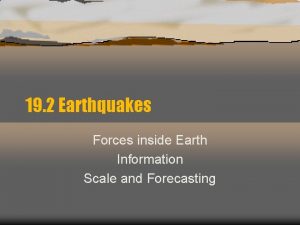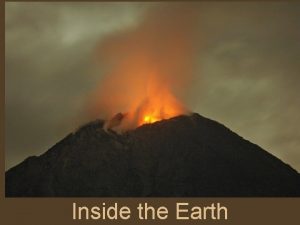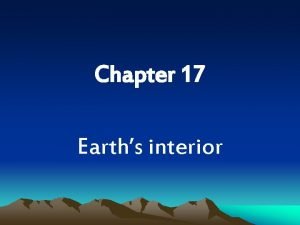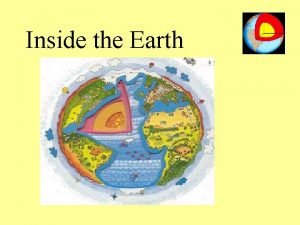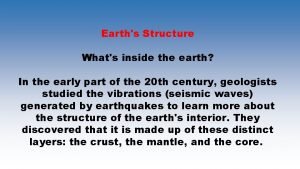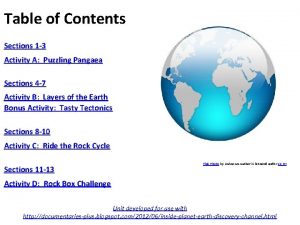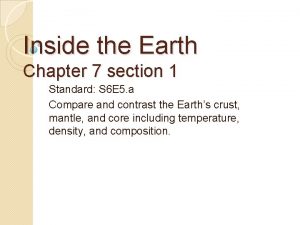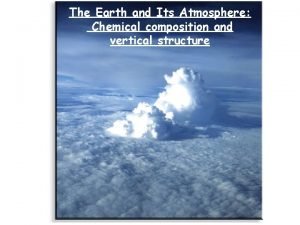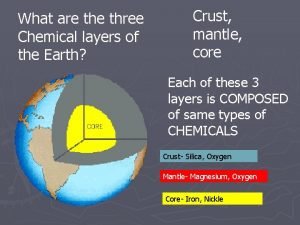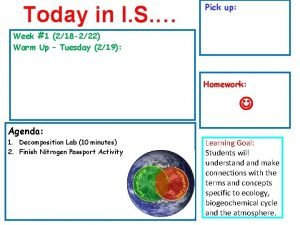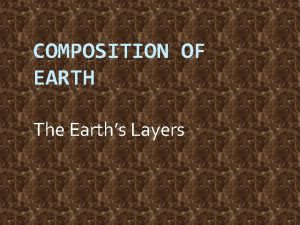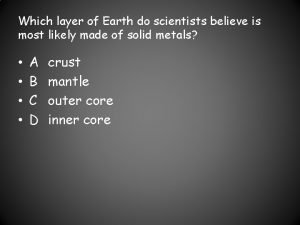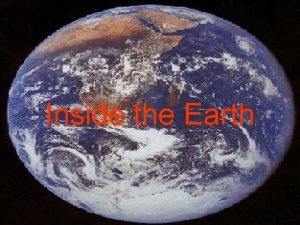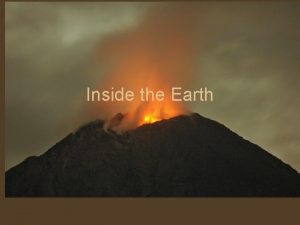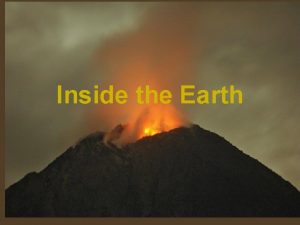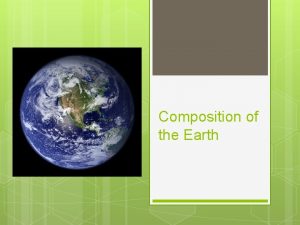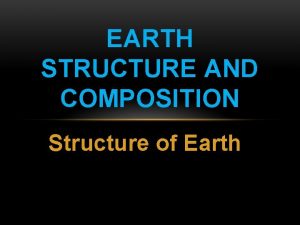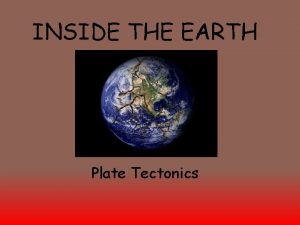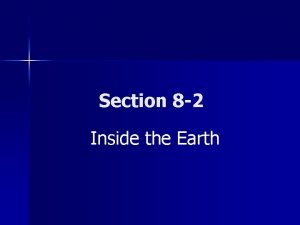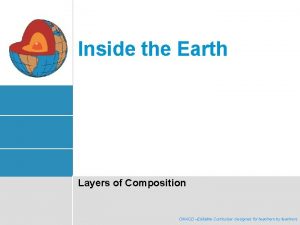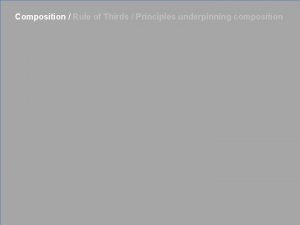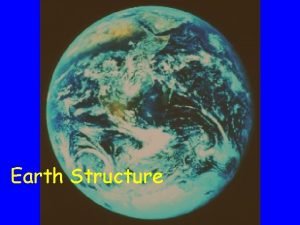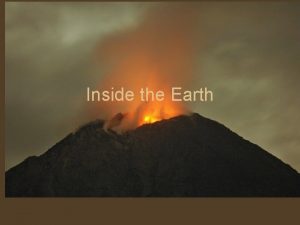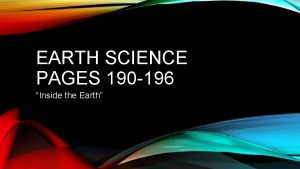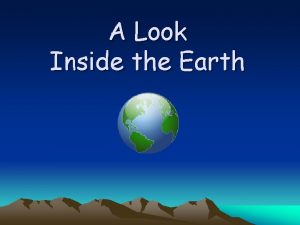Inside the Earth Composition What it is made




















































- Slides: 52

Inside the Earth

Composition (What it is made of) • Crust • Mantle • Core

Physical Structure of the Earth (5 Layers) • Lithosphere- rigid outer layer (crust) • Asthenosphere- solid rock that flows slowly (like hot asphalt) • Mesosphere- middle layer • Outer Core- liquid layer • Inner Core- solid, very dense

The Crust • Outer layer • 5 -100 km thick • 2 types of crust – Oceanic (very dense, made of basalt) – Continental (less dense, made of granite)

2 Types of Plates • Ocean plates - plates below the oceans • Continental plates - plates below the continents

Oceanic and Continental Crust

The Mantle • Middle layer • Very thick layer

The Core • Made mostly of iron • 1/3 of the earth’s mass • Very hot

Earth’s Layers • How are the earth’s layers similar to an egg? • Shell=crust • Egg white=mantle • Yolk=core

Physical Structure of the Earth (5 Layers) • Lithosphere- rigid outer layer (crust) • Asthenosphere- solid rock that flows slowly (like hot asphalt) • Mesosphere- middle layer • Outer Core- liquid layer • Inner Core- solid, very dense

What is the Lithosphere? • The crust and part of the upper mantle = lithosphere – 100 km thick –Less dense than the material below it so it “floats”

What is the Asthenoshere? • The plastic layer below the lithosphere = asthenosphere • The plates of the lithosphere float on the asthenosphere



Tectonic Plates • Earth’s crust is broken into about 19 pieces • These plates move on top of the asthenosphere

Theory of Plate Tectonics Plate Boundaries Causes of Plate Tectonics

Plate Tectonics

What is Plate Tectonics • The Earth’s crust and upper mantle are broken into sections called plates • Plates move around on top of the mantle like rafts


Questions. . . • What is theory of plate tectonics? • What is the lithosphere? • What is the asthenosphere? • What is the connection between the two? • What are the two types of plates?

Plate Boundaries

Types • Divergent – Rifting • Convergent – Sub-duction • Transform Fault Boundaries – (Sliding)

Divergent Boundaries • Boundary between two plates that are moving apart or rifting • RIFTING causes SEAFLOOR SPREADING

Divergent Plate Movement: Seafloor Spreading • the movement of two oceanic plates away from each other (at a divergent plate boundary), which results in the formation of new oceanic crust (from magma that comes from within the Earth's mantle) along a a mid-ocean ridge. • Ocean floor spreading was first suggested by Harry Hess and Robert Dietz in the 1960's.


Features of Divergent Boundaries • Mid-ocean ridges • rift valleys • fissure volcanoes






Convergent Boundaries • Boundaries between two plates that are colliding • There are 3 types…

Type 1 • Ocean plate colliding with a less dense continental plate • Subduction Zone: where the less dense plate slides under the more dense plate • VOLCANOES occur at subduction zones


Andes Mountains, South America

Type 2 • Ocean plate colliding with another ocean plate • The less dense plate slides under the more dense plate creating a subduction zone called a TRENCH

• Two Oceanic Plates - When two oceanic plates collide, one may be pushed under the other and magma from the mantle rises, forming volcanoes in the vicinity

• Two Oceanic Plates - When two oceanic plates collide, one may be pushed under the other and magma from the mantle rises, forming volcanoes in the vicinity

Aleutian Islands, Alaska

Type 3 • A continental plate colliding with another continental plate • Have Collision Zones: –a place where folded and thrust faulted mountains form.

• Two Continental Plates - When two continental plates collide, mountain ranges are created as the colliding crust is compressed and pushed upwards.



Transform Fault Boundaries • Boundary between two plates that are sliding past each other • EARTHQUAKES along faults

• When two plates move sideways against each other (at a transform plate boundary), there is a tremendous amount of friction which makes the movement jerky. • The plates slip, then stick as the friction and pressure build up to incredible levels. When the pressure is released suddenly, and the plates suddenly jerk apart, this is an earthquake.


San Andreas Fault, CA

Questions. . . • What are the types of boundaries? • What direction do plates go for each? • Which boundary has a subduction zone…what occurs at a subduction zone?

Causes of Plate Tectonics

Convection Currents • Hot magma in the Earth moves toward the surface, cools, then sinks again. • Creating convection currents beneath the plates that cause the plates to move.


Questions. . . • What causes plates to move? • How is a convection current formed?
 Forces inside earth
Forces inside earth Why is the inside of the earth hot
Why is the inside of the earth hot Three compositional layers of the earth
Three compositional layers of the earth Forces inside earth
Forces inside earth A dense ball of solid metal.
A dense ball of solid metal. Produced from the heat inside the earth
Produced from the heat inside the earth What is inside of earth
What is inside of earth Whats inside the earth
Whats inside the earth Discovery channel inside planet earth worksheet answer key
Discovery channel inside planet earth worksheet answer key Composition of the earth's crust
Composition of the earth's crust Chapter 7 section 1 inside the earth answer key
Chapter 7 section 1 inside the earth answer key Earth's atmosphere composition
Earth's atmosphere composition Mesosphere earth layer composition
Mesosphere earth layer composition Earth chemical layers
Earth chemical layers Edible aquifer lab activity answers
Edible aquifer lab activity answers The 4 layers of the earth
The 4 layers of the earth Which layer of earth is most likely made of solid metals
Which layer of earth is most likely made of solid metals What is the center of the earth made of
What is the center of the earth made of Một số thể thơ truyền thống
Một số thể thơ truyền thống Thế nào là hệ số cao nhất
Thế nào là hệ số cao nhất Ng-html
Ng-html Hệ hô hấp
Hệ hô hấp Bảng số nguyên tố lớn hơn 1000
Bảng số nguyên tố lớn hơn 1000 đặc điểm cơ thể của người tối cổ
đặc điểm cơ thể của người tối cổ Các châu lục và đại dương trên thế giới
Các châu lục và đại dương trên thế giới Tư thế worms-breton
Tư thế worms-breton ưu thế lai là gì
ưu thế lai là gì Tư thế ngồi viết
Tư thế ngồi viết Thẻ vin
Thẻ vin Cái miệng bé xinh thế chỉ nói điều hay thôi
Cái miệng bé xinh thế chỉ nói điều hay thôi Các châu lục và đại dương trên thế giới
Các châu lục và đại dương trên thế giới Mật thư anh em như thể tay chân
Mật thư anh em như thể tay chân Bổ thể
Bổ thể Từ ngữ thể hiện lòng nhân hậu
Từ ngữ thể hiện lòng nhân hậu Tư thế ngồi viết
Tư thế ngồi viết Thế nào là giọng cùng tên?
Thế nào là giọng cùng tên? Thơ thất ngôn tứ tuyệt đường luật
Thơ thất ngôn tứ tuyệt đường luật Alleluia hat len nguoi oi
Alleluia hat len nguoi oi Hươu thường đẻ mỗi lứa mấy con
Hươu thường đẻ mỗi lứa mấy con Diễn thế sinh thái là
Diễn thế sinh thái là Vẽ hình chiếu vuông góc của vật thể sau
Vẽ hình chiếu vuông góc của vật thể sau Phép trừ bù
Phép trừ bù Công thức tiính động năng
Công thức tiính động năng Tỉ lệ cơ thể trẻ em
Tỉ lệ cơ thể trẻ em Thế nào là mạng điện lắp đặt kiểu nổi
Thế nào là mạng điện lắp đặt kiểu nổi Lời thề hippocrates
Lời thề hippocrates đại từ thay thế
đại từ thay thế Vẽ hình chiếu đứng bằng cạnh của vật thể
Vẽ hình chiếu đứng bằng cạnh của vật thể Quá trình desamine hóa có thể tạo ra
Quá trình desamine hóa có thể tạo ra Môn thể thao bắt đầu bằng chữ f
Môn thể thao bắt đầu bằng chữ f Hát kết hợp bộ gõ cơ thể
Hát kết hợp bộ gõ cơ thể Sự nuôi và dạy con của hươu
Sự nuôi và dạy con của hươu Dạng đột biến một nhiễm là
Dạng đột biến một nhiễm là
